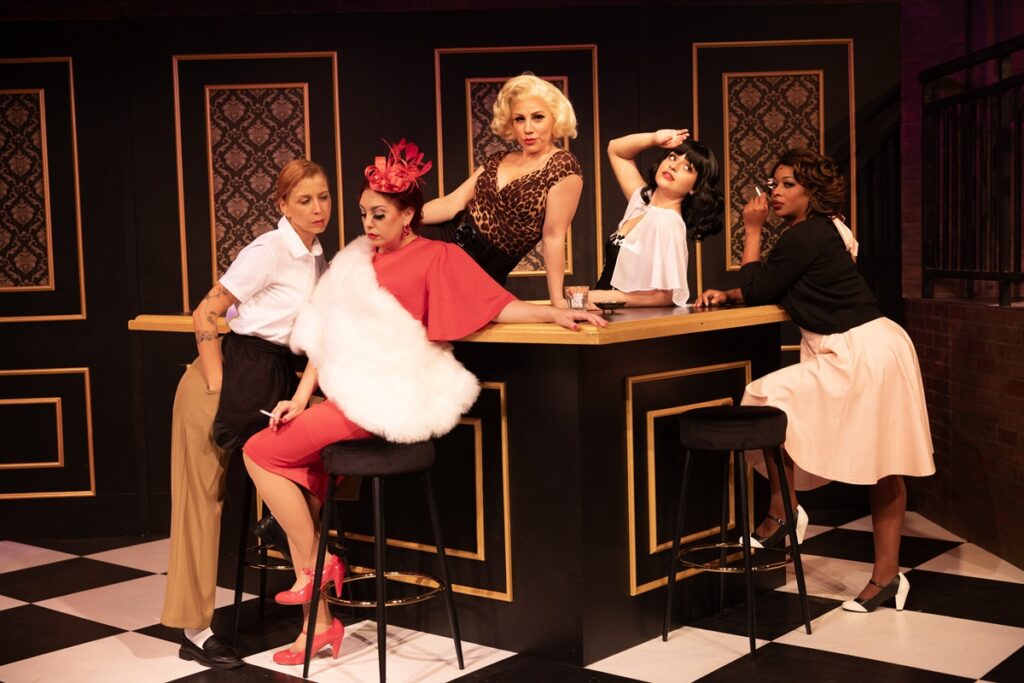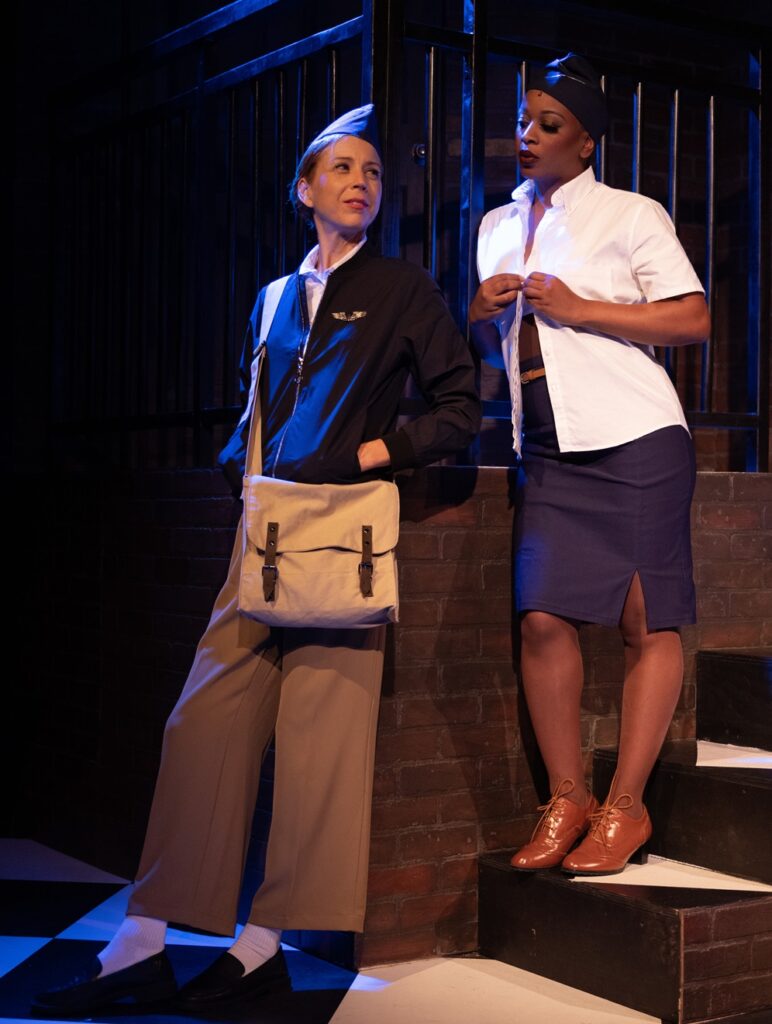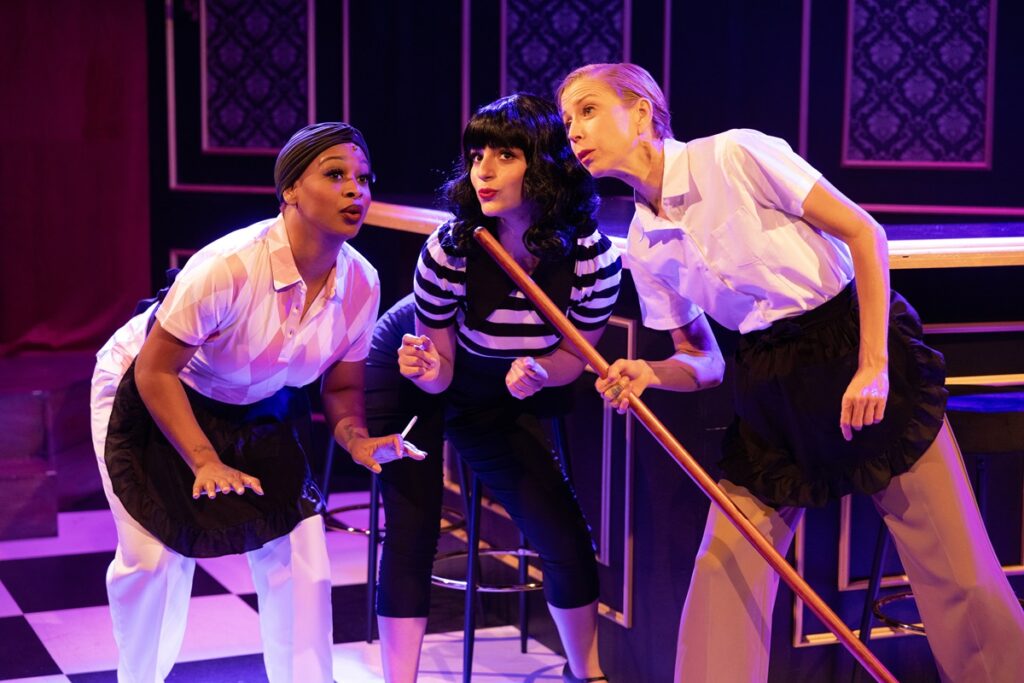
The fascinating assemblage of lesbians in Pulp. Photos: Matthews Tibbins
By Aaron Krause
“I’m a lesbian. Plain and simple. I don’t make any bones about it,” a character says more than once in Pulp, a sexy, sassy, steamy, and seductive play with music.
Of course, if the piece were set in the present, such a comment might not surprise us. Indeed, it’s been a while since same-sex marriage became legal in this country, and we would hope that people in 2024 America feel free to openly declare their sexual orientation.
But Pulp, running at Island City Stage (ICS) in Wilton Manors through May 5 in a fulfilling production, takes place in 1956. Certainly, it was a time when “people of a certain ilk” mostly kept themselves in the closet for fear of serious consequences and perhaps embarrassment. So, you have to admire the heroine Terry Logan in Patricia Kane’s Pulp for being so upfront about her identity.
Fortunately for lesbians who did not possess such courage, they could turn to lesbian pulp fiction to read about and see pictures of people like themselves.Indeed, the lesbian pulp fiction books of the 1950s and 1960s made up a thriving business for various publishers. In fact, pulps’ popularity made them available to women nationwide. It provided them with a sense of inclusion, especially for closeted lesbians in a smaller town.
These days, artists such as Kane are keeping the genre alive. Specifically, Kane’s Pulp is a fond homage to the sultry and jazzy world of 1950’s lesbian pulp fiction. And while the play is funny at times, it doesn’t mock the genre. Rather, you could say the piece has gentle, affectionate fun with lesbian pulp fiction. And Pulp is racy, but never raunchy.
The play is a stylized piece “in a Barbara Stanwyck/great old movie kind of way,” in Kane’s words. For instance, throughout the piece’s roughly 100 intermission-less minutes, the actors strike poses that echo the covers of lesbian pulp fiction novels. More specifically, immediately after a performer utters certain phrases, the action momentarily freezes and lighting designer Ardean Landhuis shines a bright light onto the stage while an actress strikes a pose. A sound effect further enhances the moment. To director Nicole Stodard’s and the cast’s credit, these moments occur naturally, with no hint of them coming.
The play tries to capture lesbian pulp fiction’s overheated, noirish feel, and ICS’s production succeeds at doing so. That is thanks, in part, to Stodard’s careful direction, Landhuis’s moody lighting, and the heat that suffuses the performers’ portrayals.
To their credit, the actors deftly capture the style of the piece while remaining natural and true to their characters. We never question the characters’ sincerity. In addition to their acting prowess, the performers possess strong, clear voices. They use them to sing the show’s original period songs under Bobby Peaco’s solid musical direction. Kane wrote the lyrics, while Amy Warren and Andre Pluess composed the music.
While Pulp is heavy on style, it is thin on story. If you are looking for a complex or unpredictable narrative, look elsewhere.
True, Pulp is an affectionate sendup of lesbian pulp fiction. However, Kane did not base her play on any one story. The tale takes place in 1956 Chicago and briefly in Joliet, Ill. and Alabama.

Autumn Kioti Horne bidding farewell to “a friend.”
As the play opens, Logan is bidding farewell to the Women’s Army Corps. following her inappropriate relationship with the general’s daughter. After she leaves, Logan boards a train headed to Chicago, and meets Pepper, a fellow lesbian. Once they arrive in the Windy City, Pepper introduces her new girlfriend to The Well, a steamy lesbian bar where Pepper and her friends frequently hang out and perform during cabaret nights.
Soon, Logan meets sexy, cynical Bing, but really becomes attracted to The Well’s mysterious owner, Vivian.
Pepper, who peppers her speech with lines from Barbara Stanwyck movies, longs to be with Winny.
Everything turns out well for the characters in the end. Ultimately, the piece is about taking a chance on love, and being personally honest and self-accepting. In addition to serving up wisecracks, the characters are intimate with each other and allow themselves to be vulnerable with one another.
For the most part, the characters possess big, seductive personalities. The exception is Winnie, whom Sheena O. Murray portrays with an appealing modesty and touching sensitivity.
In fact, one of the most moving scenes plays out between Winnie and Pepper (a bubbly Valeria Di Babbo, a dark-haired actress sporting red lipstick and smiling brightly).
But in this particular scene, the two women look at each other with tenderness as they truly realize that they deeply love each other. You feel, in particular, for Murray’s Winnie. Prior to this scene, the character seemed believably sweet but insecure, so you’re happy for Winnie that she found true love and acceptance.
In stark contrast to the aforementioned gentle scene, a primal, practically animalistic moment transpires between Logan and Vivian Blaine. Specifically, as Logan crawls on a table in pursuit of Blaine, you feel as though you are watching two primitive beasts going at each other, and you wonder when they will start grunting.
Generally, though, Autumn Kioti Horne and Leah Sessa imbue Logan and Blaine, respectively, with human characteristics.
Horne, with straight, blondish hair sometimes hidden by a hat, looks something like a tomboy as Logan. She lends her assertive character an independent air while mixing in charm as she talks with a southern drawl. Logan utters lines such as “I’m a lesbian. Plain and simple. I don’t make any bones about it.” As Horne portrays her, Logan says the line with confidence without sounding arrogant.
Speaking of confidence and arrogance, Sessa’s Blaine possesses these qualities. However, she also carries an elegance and eloquence that help to offset her undesirable traits.
Also on stage, Sandi Stock shines as the sharp-tongued femme fatale, Bing. Stock is a force in the role, but while their acting choices are generally big, the performer seems natural in the part.
Behind the scenes, scenic designer Alyiece Moretto has created a dark space that stands mostly for “The Well.” With its dark colors, such as black, the place looks elegant and tasteful. Most likely, places such as “The Well” during the 1950s would not publicize its existence. Appropriately, Moretto has designed the space without windows through which you can look outside. The absence of such windows reinforces the idea that “The Well” is a secret haven for lesbians. Wisely, Moretto has highlighted the words “The Well,” which appear prominently in white letters against a dark backdrop.
Also behind the scenes, Landhuis’s lighting design is often appropriately dim, which accentuates the piece’s seductive quality. Brighter lighting bathes the stage at appropriate times, such as after Logan’s quote about being a lesbian, “plain and simple.” The bright lighting gives the line added emphasis.
Stodard, an award-winning director who paces the production well and smartly stages the piece, also designed the period, upscale costumes. Some of them are dark and glisten. Together with the classy set design, the elegant costumes establish “The Well” as a tasteful, classy place of gathering.
Certainly, you do not have to be female or a lesbian to find value in Pulp. You also do not have to be a scholar of lesbian pulp fiction. In addition to its universal themes, such as taking a chance on love, the play includes plenty of humor. In fact, we start laughing almost from the beginning. That is when a character in the Women’s Army Corps. (WAC) named Sarge (Murray) tells Logan, “you and I both know that’s cause you been a-puttin’ your finger where you a-shouldn’ta been a-puttin it.” In other words, Logan was screwing around with the wrong person, so it made sense that she had to leave the WAC. To which Logan responds, “It’s always been a talent of mine.”
In addition to wisecracks, Pulp includes clever double-entendres and calls for classic deadpan delivery, which this cast nails.
After the reviewed performance, an audience member told ICS Artistic Director Andy Rogow “all I can say is Carbonell.”
Obviously, he was opining that the production deserves a Carbonell Award. No argument here.
Pulp at Island City Stage through May 5 at 2304 N. Dixie Highway in Wilton Manors. Tickets: Call (954) 928-9800 or send an email to md@islandcitystage.org.








 A PaperStreet Web Design
A PaperStreet Web Design
